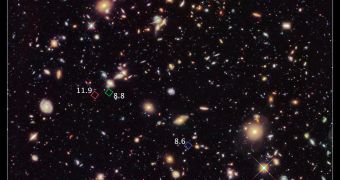Hubble may be the best known space telescope around, the only known space telescope in fact, but it's actually quite old and there are plenty of instruments in space and some even on Earth that can outperform it for some tasks or have a much broader use.
But that doesn't mean the venerable telescope is obsolete, quite the contrary, it's still the source of some very interesting discoveries.
Most recently, it helped scientists find seven of the youngest galaxies ever seen. The youngest is from when the Universe was just 380 million years old, they're mere babies on the cosmic time scale.
In fact, these are some of the first galaxies ever to exist, if our model of the early Universe is accurate. Hubble stared at a very tiny portion of space for a very long time, 100 hours during August and September 2012.
It uses its infrared camera to scan a region dubbed the Hubble Ultra Deep Field, a part of the sky where Hubble had already made observations and cataloged thousands of galaxies. None was as old as these ones though.
All of the seven galaxies observed now date from when the Universe was 600 million years old at most, meaning infrared light is all that reaches us due to the extreme red shift effect over this expanse of time and space.
The light took over 13 billion years to reach us, those galaxies may not even be around anymore. The furthest galaxy is 13.3 billion light years away, the most distant ever discovered.
The Hubble Ultra Deep Field is essentially an empty piece of space, it was chosen specifically because nothing visible had been discovered there. Hubble found thousands of galaxies at a first glance and these really young (or really old depending on how you look at it) ones at a closer inspection.
But these are the very limits of what Hubble can do, it's unlikely it is able to detect galaxies significantly younger than these ones. When and if the James Webb Space Telescope is finally deployed, astronomers will be able to look a lot further than this, even deeper into the history of the Universe, closer to the period of time when the Universe became transparent.

 14 DAY TRIAL //
14 DAY TRIAL //